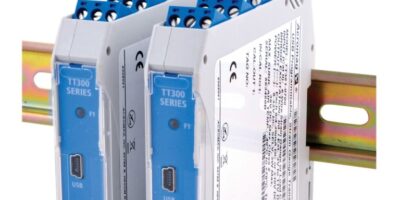Strain gauge load cell transmitters use software for precise conversion
Software provides signal conditioning in the TT351 load cell and strain gauge signal conditioners, released by Acromag.
A USB port simplifies the set up on a Windows PC or Android mobile device, using the company’s Agility app. Users can set the sensor type, bridge configuration, excitation source, filtering level, and input/output ranges via the software menu. Advanced capabilities let users finetune scaling of I/O signals, adjust excitation levels and calibrate the bridge. The universal output supports six ranges including 4.0 to 20mA, 0 to 10V and ±10V. Input is 9 to 32V DC at the terminals and a rail power bus option can be used to supply multiple units from a single connection or establish redundant power. The narrow 17.5mm housing mounts easily on a DIN rail. The transmitters have hazardous location approvals, high noise immunity and operate at -40 to 70 degrees C, making them suitable for use in harsh environments.
The TT351 input circuit allows true six-wire bridge measurement and includes an adjustable bridge excitation supply (4.0 to 11V DC) with a remote sense feature. Sense wires ensure the programmed excitation voltage is applied at the sensor and enable lead-wire compensation. The differential input performs true ratiometric conversions for stable measurements that remain accurate over time and temperature, claims the company. Lead break detection is inherent, while three-way isolation between input, output and power increases safety and noise immunity.
A single model can process strain gage, load cell, and mV input signals from 1.0 to 10mV/V. Initial bridge offsets or forces can be automatically removed with null compensation, tare, and zero balance bridge functions.
An internal half-bridge can perform half and quarter bridge completion with precision resistor pairs or bias a floating mV input signal. A custom input signal linerariser function supports up to 25 user defined signal breakpoints. Flexible scaling is independently adjustable on the input and output. To suppress noise effects, users can set a variable digital input filter level or average a number of samples. Shunt calibration tools with a simulation calculator enables rescaling of the transmitter’s indicated strain by modifying software gain and/or the instrument gauge factor.




